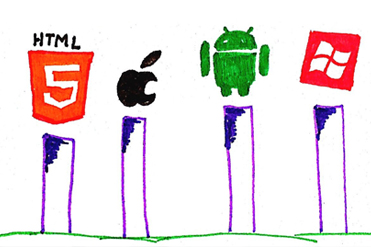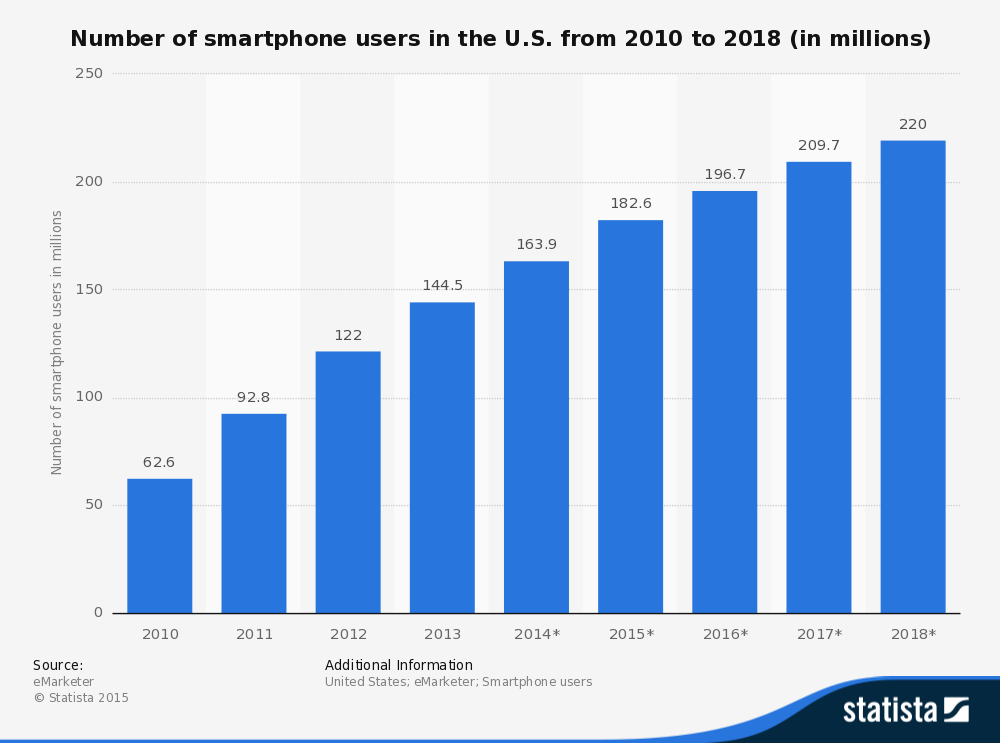

Cross-platform mobile development means creating a singular environment for mobile apps so that they can be used on multiple mobile platforms and devices. To be able to send across iOS, Android, Windows Mobile, BlackBerry/RIM, etc., cross-platform mobile development is an effective tool, and the practice is affectionately referred to as BYOD, or Bring Your Own Device.
Consider this, a survey of number of smartphone users in the U.S. from 2010 to 2018 expected in millions.

Source: Statista
A company cannot limit themselves to the tools current customers use. Instead, they must develop for all platforms in hopes of reaching the most people.
SPINX has developed a handy list of tools to create mobile apps. Using these tools is beneficial, because they drastically decrease development and testing costs. Most require knowledge of mainstream programming languages, from HTML to Java to Ruby. Using a single codebase allows a company to leverage one product across many platforms without re-developing the product multiple times.
1. Sencha. The main draws of Sencha are ease of testing applications and focus on visually compelling final products. Their tools are tested by hundreds of developers to create an easy, seamless design experience. Making a beta product and testing it on users has never been easier. Sencha is used by more than 2 million app developers and by more than 60% of Fortune 100 companies creating customer-oriented apps, making this tool a must-have for business apps. Sencha also has a forum with more than a hundred thousand active members, all troubleshooting for one another.
2. Xamarin. This application creation software is aimed at C# developers and is delivered to Apple and Android, though other platforms are available. Xamarin is meant for users with heightened programming experience, and lets developers call in house API’s in the final app. It uses .NET code on runtime and is ideal for groups of programmers working on a common product. This versatility flies in the face of flat design, allowing developers to create products that shrug off common design traps of yesterday.
3. PhoneGap. The true power of PhoneGap is in its efficiency. Most die-hard developers will love the extra support for GPS, accelerometers, and a giant library of tutorials. The tutorials allow newbies to focus on aspects of development with which they are unfamiliar, and the entry tutorials help users with no previous development experience. PhoneGap also supports an active forum and flourishing community where users voluntarily offer creative solutions to innovative problems.
Apps developed by PhoneGap are reached by more than 2 billion mobile users, and are supported by Symbian, Palm, Blackberry, Apple, Android, and more. Because of the massive community and wealth of tutorials, apps requiring novel features work best with PhoneGap.
4. Appcelerator Titanium. Like many of the other tools, Appcelerator Titanium is built to port to nearly every mobile device on the market. With robust testing capabilities and more than 336 million devices running Appcelerator-powered apps, this software is extremely popular and optimized for all data sources.
What helps Appcelerator Titanium stand out is its commitment to analytical tools. Developers can quickly and easily track use frequency, bug reports, performance, app crashes, and user demographics. This tool requires a working knowledge of JavaScript to code, but those with the correct training will find the debugging tools to rival any other software on the market.
5. Whoop. This platform’s claim to fame is acknowledging non-developers. Engineers without coding experience easily pick up Whoop and enter the competitive app market. It provides a wealth of user support and tutorials.
Due to its aim at the less-experienced, Whoop suffers from simplicity. The UI is simple, and as a result there are limitations to what developers can accomplish. On the plus sidce, tt ships very easily to Apple, Android, and Windows products. The best part of Whoop is that it is free.
6. WidgetPad. Developers who wish to use a web browser to create apps will enjoy Widgetpad. This software is still in beta, but developers will find that all the core features allow them to produce solid, finished products. Some of the more advanced features, like Android’s GPS chips, are lacking, but like Whoop, it is easy to develop, and app creators can update their products as new versions are released.
7. MoSync. Advanced software developers will love MoSync. This product provides the regular kits that work on almost all devices. MoSync is also known for providing tools that follow the latest trends, ensuring long-term app success as the emerging, and very volatile, mobile market takes shape.
It handles all the normal programming languages, including PHP, Python, Ruby, Java, Javascript, and C. MoSync is set apart from other devices because of its potential; it allows advanced developers to flex their creative muscles without compromising UX.
8. RhoMobile. Ruby is a very popular, powerful programming language with a legion of die-hard fans. RhoMobile specializes in Ruby, shipping products seamlessly to Windows Mobile, Android, RIM, Apple, and Symbian devices. RhoMobile provides mid-range capabilities, so developers just getting their feet wet can still experiment with some depth.
Unlike many of the tools on our list, RhoMobile has special plugins of its own to improve user experience. One such plugin, called RhoHub, allows for cloud hosting from a single server, so developers can easily create new software from different parts of the country.
We publish regular articles regarding innovative website solutions, mobile and tablet apps, online marketing, and more. We can help you decide which platform is best for your business.
Feature image Source: Flickr
The post 8 Dynamic Cross-Platform Tools for Mobile Developers of Any Skill Level first appeared on Web Design & Digital Marketing Tips.